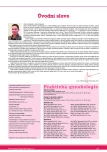Management of recurrent ovarian cancer
Authors:
M. Tkáčováihash2 1,2 1,2
Authors‘ workplace:
Onkologický ústav sv. Alžbety, a. s., Bratislava, Slovenská republika
1; I. onkologická klinika, LF UK a UN Bratislava, Slovenská republika
2
Published in:
Prakt Gyn 2011; 15(3-4): 192-195
Category:
Review Article
Overview
Up to 70% of patients with advanced ovarian cancer experience disease relapse after a primary treatment. Treatment of recurrent ovarian cancer is not curative. New cytostatics and treatment regimes improve efficacy of the second line therapies and thus ovarian cancer becomes a chronic disease. Surgical management with a complete resection of macroscopic disease should be considered as part of the treatment strategy for a relapsing disease. Positive response with respect to the quality of life and improved overall survival of patients with recurrent ovarian cancer may be achieved with a combination of cytoreductive surgery and systemic treatment.
Key words:
ovarian cancer – relapse – secondary cytoreduction
Sources
1. Armstrong D. Ovaries and fallopian tubes. In: Abeloff MD et al (eds). Abeloff’s Clinical Oncology. 4th ed. Philadelphia: Churchill Livingstone Elsevier 2008: 1827–1856.
2. Heľpianska L et al. Karcinóm ovária. Bratislava 2006: 12–15, 31–37, 63–77, 94–113.
3. Gertig D, Hunter D. Ovarian cancer. In: Adami HO, Hunter D, Trichopoulos D (eds). Textbook of cancer epidemiology. New York: Oxford University Press 2002: 378–399.
4. Safaei Diba C, Pleško I, Obšitniková A et al. Incidencia zhubných nádorov v Slovenskej republike 2005, Národný onkologický register SR. NCZI 2009.
5. National Comprehensive Cancer Network. NCCN Guidelines. Available from: http://www.nccn.org/professionals/physician_gls/f_guidelines.asp?button=I+Agree.
6. Epithelial ovarian carcinoma. In: DiSaia PJ, Creasman WT (eds). Clinical Gynecologic Oncology. 7th ed. Philadelphia: Mosby Elsevier 2007: 313–395.
7. Leitao MM Jr, Chi DS. Surgical management of recurrent ovarian cancer. Semin Oncol 2009; 36(2): 106–109.
8. Relapsed/Refractory ovarian cancer: Decision points in diagnosis and new treatment strategies (CD-ROM). Clinical care options, LLC, 2006.
9. Available from: http://www.ctu.mrc.ac.uk/news_andpress_release/news_archive/ov05_trial_asco_may_2009.as.
10. Bukowski RM, Ozols RF, Markman M. The managment of recurrent ovarian cancer. Semin Oncol 2007; 34 (2 Suppl 2): S1–S15.
11. Harter P, du Bois A, Hahmann M et al. Surgery in recurrent ovarian cancer: the Arbeitsgemeinschaft Gynaekologische Onkologie (AGO) DESKTOP-OVAR trial. Ann Surg Oncol 2006; 13(12): 1702–1710.
12. Harter P et al. Selection of the right patients for surgery in recurrent ovarian cancer. 7th European Congress: Perspectives in Gynecologic Oncology Barcelona 2010.
13. Poveda A, Vergote I, Tjulandin S et al. Trabectedin plus pegylated liposomal doxorubicin in relapsed ovarian cancer: outcomes in the partially platinum-sensitive (platinum-free interval 6–12 months) subpopulation of OVA-301 phase III randomized trial. Ann Oncol 2010; 22(1): 39–48.
14. Sehouli J, Alfaro V, González-Martín A. Trabectedin plus pegylated liposomal doxorubicin in the treatment of patients with partially platinum-sensitive ovarian cancer: current evidence and future. Ann Oncol 2011; 6: 1–7.
15. Lorusso D, Di Stefano A, Fanfani F et al. Role of gemcitabine in ovarian cancer treatment. Ann Oncol 2006; 17 (Suppl 5): v188–v194.
16. Wright JD, Hagemann A, Rader JS et al. Bevacizumab combination therapy in recurrent, platinum-refractory, epithelial ovarian carcinoma: a retrospective analysis. Cancer 2006; 107(1): 83–89.
17. Leary A, Gore M. Incorporating Bevacizumab into ovarian cancer treatment: Practical consideration. ASCO: Educational book 2011: 198–203.
Labels
Paediatric gynaecology Gynaecology and obstetrics Reproduction medicineArticle was published in
Practical Gynecology

2011 Issue 3-4
Most read in this issue
- Prolapsus uteri at vaginae totalis with Mayer’s pessary
- Applications of GnRH analogues in infertility treatment
- Cornual pregnancy carried to full term
- The reasons for severe ovarian hyperstimulation syndrome in patients requiring hospitalisation
